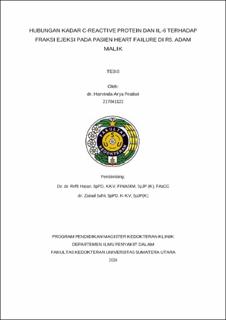Hubungan Kadar C-Reactive Protein dan IL-6 Terhadap Fraksi Ejeksi pada Pasien Heart Failure di RS. Adam Malik
Relationship between C-Reactive Protein and IL-6 Levels and Ejection Fraction in Heart Failure Patients at Adam Malik Hospital

Date
2024Author
Pratiwi, Harvinda Arya
Advisor(s)
Hasan, Refli
Safri, Zainal
Metadata
Show full item recordAbstract
Introduction: Heart failure (HF) is a progressive syndrome marked by structural and functional heart abnormalities, leading to inadequate cardiac output and high morbidity. The prevalence of HF continues to rise due to aging populations, increasing obesity and diabetes rates, and advancements in cardiovascular therapy that prolong survival. Inflammation plays a key role in HF progression, with biomarkers like C-reactive protein (CRP) and interleukin-6 (IL-6) linked to disease severity. While some studies suggest an association between elevated CRP and IL-6 levels with reduced ejection fraction (EF), findings remain inconsistent and research in Indonesia on this topic is still limited.
Aim: This study aims to evaluate the correlation between CRP and IL-6 levels with left ventricular EF (LVEF) in HF patients at Haji Adam Malik General Hospital.
Methods: This study is a cross-sectional analytic observational study, measuring CRP, IL-6, and LVEF in HF patients. CRP serves as a systemic inflammatory marker, while IL-6 is a pro-inflammatory cytokine involved in immune activation. LVEF is assessed to determine systolic function. Statistical analysis is conducted to evaluate the relationship between these variables.
Results: The findings indicate no significant correlation between CRP and LVEF (p=0.391), suggesting that CRP may not directly reflect systolic dysfunction. Conversely, IL-6 levels show a significant inverse correlation with LVEF (p=0.00), implying a stronger link between systemic inflammation and cardiac function.
Conclusion: These results highlight the need for a multimodal approach in HF management, incorporating inflammatory markers for risk stratification in these patients. While CRP may not be reliable as a predictor of systolic dysfunction, IL-6 appears to be more closely associated with HF severity. Further longitudinal and multicenter studies are necessary to validate these findings and explore potential therapeutic interventions targeting inflammation in HF patients.
